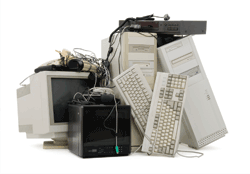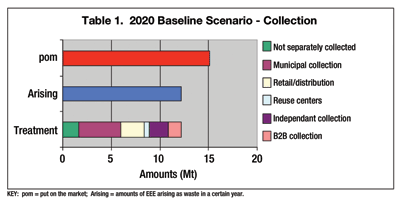The new proposals seek to simplify and clarify the original Directives, but not add substances to the banned list
BY MURRAY SLOVICK
In December the European Union Commission (EC) released its long-awaited review of the 2002/95/EC directive on the restriction of the use of certain hazardous substances in electrical and electronic equipment (the “RoHS” Directive) and the 2002/96/EC directive on waste electrical and electronic equipment (the “WEEE” Directive).
First a little background: The original RoHS Directive states in Article 6 that the EC will review the legislation in 2008 with an eye toward determining whether there should be any additional substance restrictions.
Uh-oh. Is it déjà vu all over again? Sorry, Yogi, not this time: there are no additional banned substances.

The new proposals seek to simplify and clarify the original Directives and more closely align the RoHS Directive with Europe’s REACH (Restriction, Evaluation, and Authorization of Chemical) regulations. REACH focuses on the chemical substances while RoHS is product legislation dealing only with hazardous substances in electrical and electronic equipment.
“The REACH and RoHS regulations affect the entire global supply chain and have significant implications for the success and survival of our industry,” said Dan Feinberg, owner of Fein-Line Associates a consulting firm focused on the printed circuit board and assembly industries and chairman of the IPC government relations committee. IPC is a Bannockburn, IL-based trade association whose constituents include OEMs, board manufacturers, electronics manufacturing services companies and their suppliers. IPC has been conducted lobbying efforts with the EU on RoHS revisions over the past two years.
The original RoHS ban of four heavy metals (lead, cadmium, mercury, hexavalent chromium) and two categories of brominated flame retardants (PBBs and PBDEs), which began in July 2006 remain in effect. According to the Commission, the RoHS Directive has resulted in reducing the quantities of banned substances being disposed of and potentially released into the environment by 89,800 tons of lead, 4,300 tons of cadmium, 537 tons of hexavalent chromium, 22 tons of mercury and 12,600 tons of Octa-BDE5. By the way, in the U.S. about 70% of heavy metals (mercury and cadmium) in our landfills come from electronic waste. Consumer electronics make up 40% of the lead in landfills, according to an Environmental Impact Assessment Review performed in 2005.
In particular, here’s the really good news: the EC decided not to add tetrabromobisphenol a (TBBPA) as an additional substance to be monitored or restricted under RoHS. TBBPA is the most widely used flame retardant in printed-circuit-board laminates. As an additive flame retardant it is also used in acrylonitrile butadiene styrene (ABS) used in TVs and other appliances.
“TBBPA was found to be safe for humans and the environment by a comprehensive Risk Assessment conducted by the European Union and therefore is not expected to be restricted under the EU REACH regulation,” explained Lee Wilmot, director of Environmental, Health & Safety (EHS) at TTM Technologies an independent supplier of printed circuit boards to OEMs and chair of the IPC EHS Steering Committee.
While the list of banned substances was not changed, four substances were identified for future review: Bis (2-ethylhexyl) phthalate (BEHP) used as a hydraulic fluid and, more importantly, as a dielectric fluid in capacitors, butylbenzylphthalate (BBP), mostly used as a plasticizer for polyvinyl chloride (PVC), dibutylphthalate (DBP), another plasticizer and the brominated flame-retardant hexabromocyclododecane (HBCDD), used in polystyrene foam for thermal insulation.
The current RoHS Directive also required a decision as to whether two excluded categories — 8 and 9, covering medical devices and monitoring and control instruments should be included within the scope of RoHS. The Commission now proposes adding these two categories to the RoHS Directive. Medical devices would be covered as of 2014, in vitro diagnostic equipment as of 2016, and industrial monitoring and control instruments as of 2017.
It’s not hard to see why the EU wants to reign in medical and monitoring waste. End-of-life studies show that only 49.7% of waste medical devices and 65.2% of waste control and monitoring instruments are collected separately in Europe.
New targets for the recovery/reuse and recycling of medical devices should lead to environmental benefits: according to EC studies tons of the heavy metals now banned under RoHS (more than 1,400 tons of lead and approximately 2.2 tons of cadmium) are used in medical devices and control and monitoring instruments, which account for 0.2% to 3% of waste from electrical and electronic equipment by weight.
Too few products collected and recycled
The original and continuing aims of the WEEE Directive are to prevent the generation of waste and to promote reuse, recycling, and other forms of recovery to diminish the quantity of waste discarded. According to the EC, WEEE materials and finished goods are the fastest growing waste stream in Europe, producing 8.3 to 9.1 million tons in 2005, and expected to grow to 12.3 million tons of by 2020.
The WEEE directive as currently written requires the collection, recovery and reuse or recycling of waste material. Yet a Commission study reveals that only a third of electrical and electronic equipment waste is treated according to the legislation laws and the other two-thirds either winds up in landfills (13%) or goes to sub-standard treatment sites in or outside the European Union (54%).
Apart from losing out on recycling valuable raw materials, these illegal shipments of polluting e-waste obviously have an adverse impact on the health of local populations. Based on current practice, this problem will grow rather than diminish, according to the Commission, with an estimated 4.3 million tons improperly treated each year by 2020, increasing from 3.4 million tons in 2005. The predicted collection and treatment of WEEE in 2020 is estimated in Tables 1 and 2 .


The new proposed WEEE directive aims to close the implementation gap by setting higher but more flexible targets on the collection and recycling of electrical and electronic equipment. As Directive 2002/96/EC sets no targets for the reuse of whole appliances in the 2008 revision preference is given to reusing complete electrical and electronic products.
A new binding target for the collection of EEE is established 65% by weight of all covered electrical and electronic equipment put on the market (including business-to business as well as consumer items)—and will be in effect starting in 2016. In addition, a minimum collection target is set at 4 kg per inhabitant per year from private households. The collection rate is proposed to be re-examined by the European Parliament and the Council in 2012.
Environment Commissioner Stavros Dimas said: “As modern society increasingly relies on electrical and electronic equipment it is very important that they have as little impact on the environment as possible. Making sure that certain hazardous substances do not find their way into these products and that they are properly collected and recycled when no longer used is absolutely vital. This is an opportunity for EU companies to innovate and have access to valuable raw materials as the EU seeks to maintain its leadership role in becoming a resource-efficient economy which minimizes the products’ environmental and health effects throughout their life-cycle.”
The Commission’s proposed legislation for RoHS and WEEE must be approved by both the European Parliament and Council before it becomes effective at the EU level; it must then be transposed into national law at the Member State level. Although the Commission’s proposal is likely to be very influential in determining the ultimate shape of the RoHS and WEEE revisions, amendments could be inserted during the next stages in the legislative process before the directive is finalized. We’ll let you know if that happens. ■
Advertisement
Learn more about Electronic Products Magazine





